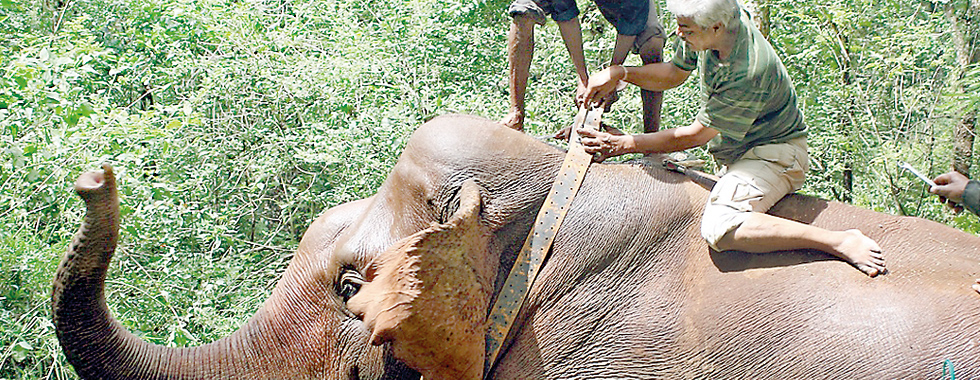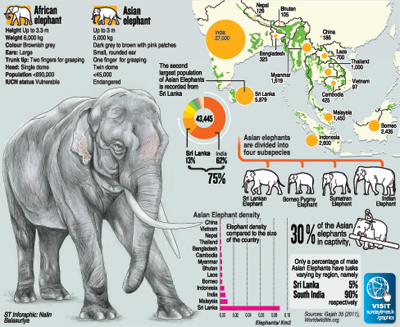News
Indian elephant expert critical of conservation methods
A scientific approach is needed to solve the Human Elephant Conflict (HEC) and Sri Lanka must not make the same mistakes that India did, Indian elephant expert Ajay Desai said. As co-chair of IUCN Asian Elephant Specialist group Mr. Desai was in Sri Lanka to deliver a talk on ‘’A Way forward with Elephants” at a forum organised by the Federation of Environmental Organisations of Sri Lanka (FEOSL), a few weeks ago.

Ajay Desai (right) fixes a radio collar to a wild elephant in India as it recovers from a tranquilizer drug (c) Swapneel Desai
Emphasising that Sri Lanka has the second largest population of Asian elephants, he said conservation was vital as HEC was the leading threat to the survival of these nimals.
“There is no single strategy that works for solving all the human elephant conflicts. Each case of HEC can be different from the other. So, just as you need to investigate the root cause of any disease before you start medication, first you need to analyse the reasons leading to HEC on a scientific basis and then only should you find lasting solutions,” the elephant expert elaborated.
Mr. Desai, a pioneer in studying the behaviour of asian elephant using radio collars, also helped train Sri Lankan scientists in this method. The study which was later carried forward by local experts such as Dr.Prithviraj revealed some elephants were confined to the national parks, some lived entirely outside the parks while the habitat of others overlapped between the parks and outer areas. These studies have shown that elephants do not roam the length and breadth of the country as earlier believed but have fixed home ranges. This demonstrates the need for properly managed elephant ranges which include parks and non-park areas.
“I also predicted then that if you drive elephants (females) out of their home ranges and enclose them with fences outside their home range they will disperse and cause severe problems or they will die eventually due to starvation and stress. This happened with the drive in Hambantota to Lunugamwera,” Mr. Desai said highlighting the research results by Dr.Prithviraj years after the infamous elephant drive.
“But sadly there is no real or rather soft solutions to the Human Elephant Conflict due to isolated pockets of elephants. As you cannot undo habitat loss or fragmentation to the level that would allow elephants to live successfully then there is no future for these elephants. The solutions are simple yet impossible,” Mr. Desai told the Sunday Times.

“Firstly you can try to revert the habitat back to what it was. But remember, that just confining them to a small sub-area of their original home range will lead to compression of elephants and they will ultimately die out. Secondly, translocation – but the problem is that there are no empty habitats into which you can translocate elephants as all areas are over-crowded and none of the areas are effectively fenced to keep the elephants in. Capture them and bring them into captivity is the third option, but there are too many in the isolated populations. The cost of maintaining them properly will be too high and there would be less trained man-power to handle them. So the elephants will get a life time of captivity and eventual die without giving any conservation gains,” he said.
Considering all these failed options Mr. Desai said there was a fourth option—the difficult choice of culling these elephants in ‘troubled’ spots. He said this method was cost effective and would even have conservation gains such as using funds to conserve other viable elephant populations. It would also bring a quick end to these elephants instead of a slow lingering death which is what actually awaits them or a life time in captivity and death in the end.
“We persist, however, with attempts at conservation even in smaller areas and in fragmented habitats. It is not because we care for elephants but because we do not want to step-up to scientific and pragmatic conservation – because we do not want to take hard decisions or pay for our past errors (mismanaging forests and not taking technically sound decisions). Will we ever become honest and mature enough to understand and accept what conservation is really about? The elephant expert asked.
He said what is practised both in India and Sri Lanka is to ignore the root cause and provide patching up medications that have no long term gains or solutions. In the meantime elephants remain in conflict and people retaliate by shooting, electrocuting or poisoning them. “Eventually over a period of time they will die out but in the process you waste conservation money, lose human life and cause misery to elephants,” he pointed out.
Pointing out that Wildlife Conservation Departments alone cannot provide solutions to the human elephant conflict, Mr. Desai hit out at unplanned development carried out by various ministries and individuals. He said India was already facing the consequences of rapid unplanned developments in elephant habitats without consultation with conservationists. “The pity of it is that had consultations taken place before this and, much cost and loss of life, both of people and elephants, could have been avoided,” Mr.Desai said warning that Sri Lanka appeared to be taking the same path .
“All those who are responsible for rapid and unplanned development too should be held accountable,” the outspoken elephant expert said.
FEOSL: Umbrella group for environmental organisations
Ajay Desai’s lecture was organised by the Federation of Environmental Organisations (FEOSL), an umbrella of environmental organizations, which was launched last year in Sri Lanka.
“There are many environmental issues that we managed to solve positively by working together. As the pressure for development grows the environment unfortunately becomes the victim,” a spokesperson of the FEOSL told to the Sunday Times at their first Annual General Meeting held last month.
comments powered by Disqus
